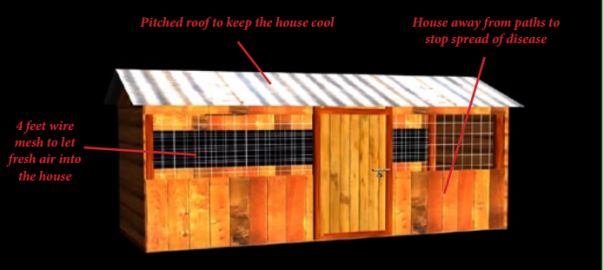In most of our articles, we have placed an emphasis on the importance of good stockmanship in poultry raising. Success in poultry farming requires a great deal of expertise, knowledge of poultry and the poultry farming enterprise as well as great commitment in order to realize success in the venture.

While good flock stockmanship will help you realize success, a lot is also anchored on the quality of the infrastructure that you have put in place. You have to build the correct poultry housing and use the right sets of equipment that will help you maximize on your production. In poultry farming, good housing is generally the foundation of future success in the farming venture.
There are various aspects that you must get right when it comes to constructing poultry housing. These include the spacing, ventilation, lighting, security, orientation, design and the level of comfort provided in the poultry house.
Here is a look at some of the key considerations that you should keep in mind when constructing kienyeji chicken house or any other poultry house for your flock:-
- The kienyeji chicken house should provide your birds with a strong structure and comfortable environment that helps protect them from predation and temperature and weather extremes.
- The poultry house must have adequate space suited for the stocking density of the birds. The ideal stocking density for a chicken house is one square foot per bird for broilers and two square feet per bird for layers.
- The chicken house must be open-sided in order to allow for proper ventilation of the chicken house. For optimal natural ventilation, the kienyeji chicken house should be constructed in an East-West orientation. This will help minimize the amount of sunshine that is directly entering the poultry house.
- The kienyeji chicken house should be constructed in a rectangular shape and the wall should not be higher than 3 feet on its longer side.
- Use locally available materials to make the wall and cut down on the cost of poultry house construction. Some of the local materials that you can use include timber offsets, iron sheets, bricks, mud stones and iron sheets.
- The rest of the sides of the poultry house wall should be made with a chicken wire mesh. The chicken wire mesh on the sides of the poultry house should be of small gauge so as to prevent rodents and wild birds from getting into the poultry house.
- The roof of the poultry house ought to have a reflecting surface for better ventilation. For better ventilation, it should also be pitched with overlaps.
- For flooring, use cement and then add wood shavings on top. Cement flooring is very easy to clean.
- Include a foot bath at the entrance of the poultry house where visitors can dip and disinfect their feet before they enter the chicken run and poultry coop.
- All the vegetation around the poultry house should be cleared to reduce the risk of rodents and other crawlies gaining entrance into the poultry house. Clear all vegetation within a radius of 3 to 5m of the poultry house.